Matrix Metalloproteinases Retain Soluble FasL-mediated Resistance to Cell Death in Fibrotic-Lung Myofibroblasts
- PMID: 32053892
- PMCID: PMC7072292
- DOI: 10.3390/cells9020411
Matrix Metalloproteinases Retain Soluble FasL-mediated Resistance to Cell Death in Fibrotic-Lung Myofibroblasts
Abstract
A prominent feature of obstructed tissue regeneration following injury in general, and fibrotic lung tissue in particular, is fibroblast proliferation and accumulation. The Fas/FasL apoptotic pathway has been shown to be involved in human idiopathic pulmonary fibrosis (IPF) and bleomycin-induced lung fibrosis in rodents. We previously showed that in normal injury repair, myofibroblasts' accumulation is followed by their decline by FasL+ T cell-induced cell death. In pathological lung fibrosis, myofibroblasts resist cell death and accumulate. Like other members of the tumor necrosis factor (TNF) family, membrane-bound FasL can be cleaved from the cell surface to generate a soluble form (sFasL). Metalloproteinases (MMPs) are known to convert the membrane-bound form of FasL to sFasL. MMP-7 knockout (KO) mice were shown to be protected from bleomycin (BLM)-induced lung fibrosis. In this study, we detected increased levels of sFasL in their blood serum, as in the lungs of patients with IPF, and IPF-lung myofibroblast culture medium. In this study, using an MMP-inhibitor, we showed that sFasL is decreased in cultures of IPF-lung myofibroblasts and BLM-treated lung myofibroblasts, and in the blood serum of MMP-7KO mice. Moreover, resistant fibrotic-lung myofibroblasts, from the lungs of humans with IPF and of BLM-treated mice, became susceptible to T-cell induced cell death in a co-culture following MMP-inhibition- vs. control-treatment or BLM-treated MMP-7KO vs. wild-type mice, respectively. sFasL may be an unrecognized mechanism for MMP-7-mediated decreased tissue regeneration following injury and the evolution of lung fibrosis.
Keywords: cell death; lung myofibroblasts; matrix metalloproteinase (MMP); pulmonary fibrosis; soluble FasL (sFasL).
Conflict of interest statement
Acknowledgments: We thank Shifra Fraifeld for her editorial assistance in preparing this manuscript.
Figures
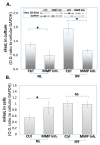
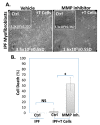
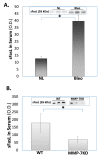
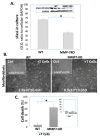
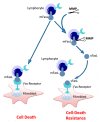
Similar articles
-
Cutting edge: FasL(+) immune cells promote resolution of fibrosis.J Autoimmun. 2015 May;59:67-76. doi: 10.1016/j.jaut.2015.02.006. Epub 2015 Mar 23. J Autoimmun. 2015. PMID: 25812467
-
Protein Tyrosine Phosphatase-N13 Promotes Myofibroblast Resistance to Apoptosis in Idiopathic Pulmonary Fibrosis.Am J Respir Crit Care Med. 2018 Oct 1;198(7):914-927. doi: 10.1164/rccm.201707-1497OC. Am J Respir Crit Care Med. 2018. PMID: 29727583 Free PMC article.
-
Forefront: MiR-34a-Knockout Mice with Wild Type Hematopoietic Cells, Retain Persistent Fibrosis Following Lung Injury.Int J Mol Sci. 2020 Mar 23;21(6):2228. doi: 10.3390/ijms21062228. Int J Mol Sci. 2020. PMID: 32210149 Free PMC article.
-
Matrix metalloproteinases as therapeutic targets for idiopathic pulmonary fibrosis.Am J Respir Cell Mol Biol. 2015 Nov;53(5):585-600. doi: 10.1165/rcmb.2015-0020TR. Am J Respir Cell Mol Biol. 2015. PMID: 26121236 Free PMC article. Review.
-
sFasL-The Key to a Riddle: Immune Responses in Aging Lung and Disease.Int J Mol Sci. 2021 Feb 22;22(4):2177. doi: 10.3390/ijms22042177. Int J Mol Sci. 2021. PMID: 33671651 Free PMC article. Review.
Cited by
-
Pharmacological and Nutraceutical Activation of Rejuvenation, Geroprotection and Cytoprotection: Proofs of Concept.Cells. 2022 Nov 26;11(23):3786. doi: 10.3390/cells11233786. Cells. 2022. PMID: 36497045 Free PMC article.
-
The Many Faces of Matrix Metalloproteinase-7 in Kidney Diseases.Biomolecules. 2020 Jun 25;10(6):960. doi: 10.3390/biom10060960. Biomolecules. 2020. PMID: 32630493 Free PMC article. Review.
-
Myofibroblasts persist through immune privilege mechanisms to mediate oral submucous fibrosis: Uncovering the pathogenesis.J Oral Biol Craniofac Res. 2024 Nov-Dec;14(6):773-781. doi: 10.1016/j.jobcr.2024.10.008. Epub 2024 Oct 20. J Oral Biol Craniofac Res. 2024. PMID: 39502133 Free PMC article. Review.
-
Matrix metalloproteinase/Fas ligand (MMP/FasL) interaction dynamics in COVID-19: An in silico study and neuroimmune perspective.Heliyon. 2024 May 15;10(10):e30898. doi: 10.1016/j.heliyon.2024.e30898. eCollection 2024 May 30. Heliyon. 2024. PMID: 38803919 Free PMC article.
-
Role of metalloproteases in the CD95 signaling pathways.Front Immunol. 2022 Dec 5;13:1074099. doi: 10.3389/fimmu.2022.1074099. eCollection 2022. Front Immunol. 2022. PMID: 36544756 Free PMC article. Review.
References
-
- Daniil Z.D., Gilchrist F.C., Nicholson A.G., Hansell D.M., Harris J., Colby T.V., du Bois R.M. A histologic pattern of nonspecific interstitial pneumonia is associated with a better prognosis than usual interstitial pneumonia in patients with cryptogenic fibrosing alveolitis. Am. J. Respir. Crit. Care Med. 1999;160:899–905. doi: 10.1164/ajrccm.160.3.9903021. - DOI - PubMed
Publication types
MeSH terms
Substances
LinkOut - more resources
Full Text Sources
Molecular Biology Databases
Research Materials
Miscellaneous

